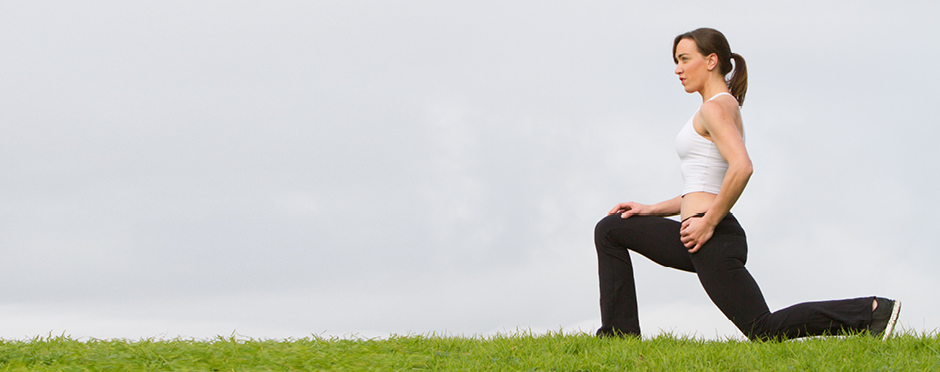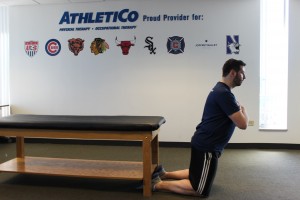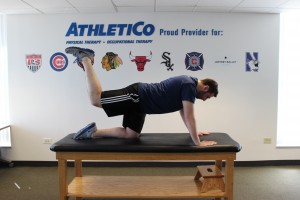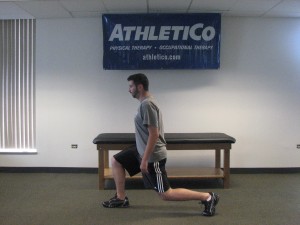
3 Solutions for Quad Dominance: A Known Injury Risk Factor
8 CommentsOne factor that athletic trainers and physical therapists look at when assessing knee injury risk is the reliance someone has between 3 groups of muscles – the quadriceps (quads), glutes, and hamstrings. Here’s a quick rundown of what these muscle groups all do:
- The quads are the muscles across the front of the thigh that are responsible for straightening the knee and helping to flex the leg forward.
- The hamstrings are located in the back of the thigh and serve the exact opposite responsibilities as the quads – they bend the knee and help extend the leg backwards.
- The glutes are located in the back and side of the hips and are responsible for helping to extend the leg backwards, move the leg away from the center of the body (abduction), and rotate the leg outwards (external rotation).
For the purposes of muscle balance around the knee, we’re usually looking at the quads as one force and the glutes and hamstrings as the other group. Ideally, we would see these two groups of muscles in balance, meaning that when you perform a movement that utilizes both groups, you’re not relying too heavily on one or the other.
The most common deficit we see is something called quad dominance, or heavily utilizing the quads for actions that would ideally use both groups. For example, when someone squats, we would like to see them move their hips back first, bending their knees as needed to achieve a good depth without letting their knees move excessively forward past their big toes. In general, when someone can squat with proper form, the demand is placed across all three muscle groups, providing less strain on any one particular part of the body. If, when you squat, your first movement is to bend at the knees or if your knees move excessively past your toes, you may be quad dominant.
Correcting quad dominance is fairly straightforward in most cases, although some people require a more individualized approach. Addressing these 3 most common deficits may not only help reduce your injury risk, but also give you a boost in strength and power as you’re recruiting powerful muscles that may not be currently used to their fullest potential!
Hamstring and Glutes Weakness
If your hamstrings and glutes are weak due to lack of use, it’s time to strengthen them up so they can start pulling their weight. Here are three exercises that will help get you started. As always, if any exercise causes you discomfort, stop immediately and contact your physician.
Russian Hamstring Curls:
 With your knees rested on a soft surface (bosu ball or padding) and a bench a few feet in front of you (as if you were going to do a pushup on it) have a partner hold your ankles down to the ground. Keeping your body in a straight line from the knee to the head, slowly lower your body towards the ground – with your arms out to catch yourself. Go as slow as you can, repeating 3 sets of 10 repetitions.
With your knees rested on a soft surface (bosu ball or padding) and a bench a few feet in front of you (as if you were going to do a pushup on it) have a partner hold your ankles down to the ground. Keeping your body in a straight line from the knee to the head, slowly lower your body towards the ground – with your arms out to catch yourself. Go as slow as you can, repeating 3 sets of 10 repetitions.
Donkey Kicks:
 Lay with on your stomach with your body completely flat. Bend one knee so that the bottom of your foot is parallel with the ceiling. Extend your leg backwards as if you were trying to put a shoe print on the ceiling. Focus on squeezing the muscles in your rear on the way up and try getting in 30 repetitions on each leg.
Lay with on your stomach with your body completely flat. Bend one knee so that the bottom of your foot is parallel with the ceiling. Extend your leg backwards as if you were trying to put a shoe print on the ceiling. Focus on squeezing the muscles in your rear on the way up and try getting in 30 repetitions on each leg.
Lunges:
 Take a slightly longer than normal step forward then bend both knees. Then slowly lower the back knee until it touches (not hits) the ground. Your front knee should stay in line with your toes and not extend past the front edge of your shoe. Push up through the heel of your front foot to return to a standing position and repeat this on the other leg. Try to complete 3 sets of 10 repetitions on each leg.
Take a slightly longer than normal step forward then bend both knees. Then slowly lower the back knee until it touches (not hits) the ground. Your front knee should stay in line with your toes and not extend past the front edge of your shoe. Push up through the heel of your front foot to return to a standing position and repeat this on the other leg. Try to complete 3 sets of 10 repetitions on each leg.
Muscle Tightness
Sometimes certain muscles take over because they are “overactive” or tight. One way to inhibit that limitation is to foam roll any tight areas you have before performing any activity. When it comes to rolling, we have some great suggestions here to get you started. One area that often gets neglected when it comes to correcting quad dominance is the ankle. A tight ankle can actually cause the body to shift weight forward towards the quads as the joints in your legs bend, so consider using some of these calf and ankle stretches to loosen things up.
Poor Mechanics
Sometimes everything is perfectly fine as far as strength and mobility go, but old habits cause you to still use your quads a bit too much. Working with an athletic trainer to watch you during sport-specific movements (i.e., squats, pivots, jump landings, etc) can help identify if you are putting too much demand on your quads. Realizing which movements need to be addressed can help you correct them in a controlled environment before you put yourself in a compromised position in competition.
It should be noted that this, by no means addresses all of the potential strength and mobility imbalances around the knee and seeking the advice of a health care professional is always preferred to taking a “1 size fits all” approach. These solutions should, however, give you a good starting point to help improve the balance in your legs!


8 Comments
harwinbalancer2
Such an outstanding post is this and it is very useful for all because it contains lots of information itself about injury risk factor.
Keep on sharing.
monica
Excellent article, thanks for posting. Hips!!!
Laura Suni
Hello!
I am a 42 years old woman from Finland. I have been suffering from quad dominance for over one year now and it has gone so far that it is hard for me to even stand without getting my tights sore/tense. I can feel the pain and tightness even when I am sleeping not being able to realx them actively, so it disturbs my sleep a lot. First I thought that I have a neurological condition, but when I visited a physiotherapist, he noticed I had gluteal amnesia and quad dominance. I do have cyringomyelia in my thoracal spine, but the neurologist thought my symptoms are not related to that. It feels very hard for me to get rid of this quad dominence and also activate my gluteal muscles. I activate my quads in every move, like doing arm exercises at the gym. Also it is very hard for me trying to activate my gluteal muscles, because the thights get tense at the same time and I am trying to avoid all the moves/positions that make it happen. Do You happen to have an idea, how I could “inactivate” them so I slept better and my life could get back in normal overall? I so appreciate, if You could help me with this problem.
Monica Flores
This post was very helpful. Thank you
Lydia
my quads are feeling great now
Ryan
I’ve been suffering with back pain for over two years and have just now figured out it is a quad dominance issue. One day I just felt I needed to stretch my quads, I don’t know why, but my body just spoke to me. My back pain significantly reduced at that time. I felt like that was the key, but stretching alone didn’t accomplish it. I’ve always been athletic and work out consistently. However, I totally neglected my gluteus and hamstrings over the last couple of years. Too much sitting (at work, at home etc.) causes backside weakness and imbalance. I started doing hamstring curls and one leg floor touches. Pretty much immediately those muscles woke up and started doing their job and I had instant pain relief and more flexibility. I was mad at myself for not realizing this earlier because it really impaired my quality of life and ability to be as active as I wanted. I’m still working on the balance and do feel slight pain at times, but I think it’s my body trying to be quad dominant again, so I work my hams and flutes and I’m good to go. For what it’s worth my wife is a physical therapist and we tried all kinds of things. Like I said, I’m athletic and muscular, so it was difficult to pinpoint. Doctor gave me steroids, which I hate taking, and took X-rays. Chiropractor made me hurt worse. Pain clinic said they would inject me. And another physical therapist tried to help as well. I truly feel like it’s been a miracle discovery about just keeping your muscles in balance. I hope more people discover this could be their problem as it may save so much time, money, and pain. Thanks for the article.
Rachel
How long does it take to correct quad dominance?
I’ve been suffering for years and have started actively focusing on flute/hamstring exercises for a few weeks but nothing yet.
Monica K
Several good points made here.
It is also important to note that the glutes also play a leading role in hip extension. This is largely important because tight/overactive hip flexors can create underactive glutes, overactive quads, AND weakened/instability of the core muscles. Since the main hip flexor connects to the spine, the result is usually — you guessed it — lower back pain.
Everything is connected, so it’s important to keep the muscles balanced at every part of the joint. No muscle left behind! 🙂